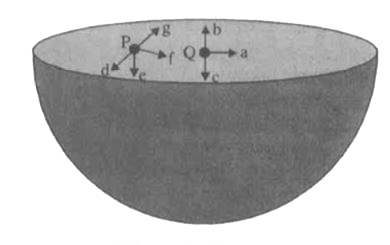For the above problem, the direction of the gravitational intensity at an arbitrary point P is indicated by the arrow (1) d, (ii) e, (iii) f, (iv) g.Solution in Gujrati
⇒ Intensity of gravitation at point P is toward e.
Topper's Solved these Questions
- GRAVITATIONBook:KUMAR PRAKASHANChapter:GRAVITATIONExercise:Section - B ADDITIONAL EXERCISE
Explore 4 Videos
- GRAVITATIONBook:KUMAR PRAKASHANChapter:GRAVITATIONExercise:Section - B Numerical From .DARPAN. Based On Textbook
Explore 9 Videos
- GRAVITATIONBook:KUMAR PRAKASHANChapter:GRAVITATIONExercise:Section - B Numericals (Numerical From Textual Illustration)
Explore 15 Videos
- LAW OF MOTIONBook:KUMAR PRAKASHANChapter:LAW OF MOTIONExercise:(QUESTION PAPER) SECTION-D
Explore 1 Video
Similar Questions
As you have learnt in the text a geostationary satellite orbits the earth at a height of nearly 36,000 km from the surface of the earth. What is the potential due to earth's gravity at the site of this satellite ? (Take the potential energy at infinity to be zero).
Mass of the earth 6.0×1024(kg) ,
Radius = 6400 km .
View SolutionThe position vector of the objects of masses 25 kg and 10 kg are (4,7,5)m and (1,3,5) m respectively. Obtain the vector representing the gravitational force on 25 kg object by 10 kg object. (Take G=6.67×10−11Nm2kg−2 )
View SolutionLet the speed of the planet at the perihelion P in figure .(a) be vp and the Sun - planet distance SP be rp . Relate {rp,vp} to the corresponding quantities at the apphelion {rA,vA} . Will the planet take equal take equal times to traverse BAC and CPB ?

View SolutionA 70 kg man stands in contact against the inner wall of a hollow cylindrical drum of radius 3 m rotating about its vertical axis with 200 rev/min. The coefficient of friction between the wall and his clothing is 0.15. What is the minimum rotational speed of the cylinder to enable the man to remain stuck to the wall (without falling) when the floor is suddenly removed ?
View SolutionThe gravitational intensity at the centre Q of the drumhead defined by a hemispherical shell of uniform mass density has the direction indicated by the arrow (i) a,(ii)b, (iii) c, (iv) zero.
View SolutionFor the above problem, the direction of the gravitational intensity at any arbitary point P is indicated by the arrow (i) d, (ii)e, (iii) f, (iv) g.
View SolutionFor the above problem, the direction of the gravitational intensity at an arbitrary point P is indicated by the arrow (i) d, (ii), e, (iii) f (iv) g.
View SolutionThe direction of gravitational intensity at point P of a hemispherical shell of uniform mass desity is indicated by the arrow
View Solutionएक समान द्रव्यमान घनत्व की अर्धगोलीय खोलों द्वारा परिभाषित ढ़ोल उपरोक्त समस्या में किसी यादृच्छिक बिंदु P पर गुरुत्वीय तीव्रता किस तीर (i) d, (ii) e, (iii) f, (iv) g द्वारा व्यक्त की जाएगी?

View Solutionउपरोक्त समस्या में किसी यादृच्छिक बिन्दु P पर गुरुत्वीय तीव्रता किस तीर (i) d, (ii) e, (iii) f, (iv) g द्वारा व्यक्त की जाएगी ?
View Solutionउपर्युक्त समस्या में किसी यादृच्छिक बिंदु P पर गुरुत्वीय तीव्रता किस तीर (i)d,(ii)e,(iii)f,(iv)e द्वारा व्यक्त की जाएगी ?
View Solutionउपर्युक्त समस्या में किसी यादृच्छिक बिंदु P पर गुरुत्वीय तीव्रता किस तीर (i)d,(ii)e,(iii)f,(iv)e द्वारा व्यक्त की जाएगी ?
View Solutionउपरोक्त समस्या में किसी यादृच्छिक बिन्दु P पर गुरुत्वीय तीव्रता किस तीर (i)d, (ii)e, (iii)f, (iv)g द्वारा व्यक्त की जाएगी ?
View SolutionFor the above problem, the direction of the gravitational intensity at an arbitrary point P is indicated by the arrow (i) d, (ii) e, (iii) f, (iv) g.
View SolutionFor the above problem, the direction of the gravitational intensity at an arbitrary point P is indicated by the arrow (i) d, (ii) e, (iii) f, (iv) g.
View Solution

